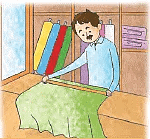Measurement of Length and Mass | Mathematics for Class 2 (Joyful-Mathematics) PDF Download
| Table of contents |

|
| Measuring Weight (MASS) |

|
| Measuring Length |

|
| How to measure using a centimetre ruler? |

|
| Summary |

|
Measuring Weight (MASS)
By using different types of weighing scales, we can measure the weight of any object. There are different types of standard units of weighing scales used such as milligrams, grams and kilograms to measure the weight of different objects. You learnt that weight of an object is measured using a balance. When the objects are placed on the pans of the balance, the heavier side goes down. When the pans balance, the weights on both the pans are same.
You learnt that weight of an object is measured using a balance. When the objects are placed on the pans of the balance, the heavier side goes down. When the pans balance, the weights on both the pans are same.In the olden days, man used to weigh an object with the help of things like marbles, wooden blocks, beans, etc. But the blocks, marbles, beans, etc. may not be of same size, so the weights could be different each time we would use them.

So, to get the same weight of an object every time it is measured, we use fixed measures, i.e., standard units like grams and kilograms and know how heavy the object is. In short, we write ‘kg’ for kilograms and ‘g’ for grams.
1000 g make 1 kg.
So, 1 kg = 1000 g.
We use grams to weigh lighter objects and kilograms to weigh heavier objects.
Examples
The following pictures show some of the commonly used weights.
Measuring Length
You have learnt in Class 1 about the various units of measuring lengths such as digit (finger width), handspan, footspan, cubit and pace.

None of the above units is a standard unit as the digit, handspan, footspan, cubit and pace, etc. differ from person to person.
So, in order to measure length of a given object correctly, we use standard units and scales.
We measure the length of an object by a metre rod or a ruler.

The standard unit of length is metre. In short, metre is written as m. In the picture shown on the right, a cloth merchant is measuring the length of cloth with a metre rod. Larger lengths such as length of a train, height of a tall tree, width of the playground, etc. are measured in metres. Smaller lengths are measured in centimetres. In short, centimetres is written as cm. Smaller lengths such as length of a pencil, width of your book, thickness of TV remote, etc. are measured in centimetres.

How to measure using a centimetre ruler?
Look at the 15 cm ruler (small ruler) that you generally use. The distance from 0 marking to 1 marking represents 1 centimetre.
As you see in the ruler shown below, the length between the centimetre markings are all equal.
To measure the length of an object, say, a pencil, put the pencil above the zero mark of the ruler. Then, read the marking on the ruler where the pencil ends. The length of the pencil is 7 cm.
Then, read the marking on the ruler where the pencil ends. The length of the pencil is 7 cm.
Summary
- Weight is measured using different weighing scales, with standard units such as milligrams, grams, and kilograms.
- A balance is typically used to measure weight, where the heavier side of the balance goes down.
- To ensure accurate measurements, we now use standard units like grams (g) and kilograms (kg), with 1 kilogram equaling 1000 grams.
- Grams are used to measure lighter objects, while kilograms are used for heavier ones.
- For measuring length, standard units like meters and centimeters are used.
- A meter rod or ruler is commonly used to measure length.
- The standard unit for larger lengths is the meter (m), while smaller lengths are measured in centimeters (cm).
- To measure with a ruler, simply place the object at the zero mark and read the measurement where it ends.
|
28 videos|262 docs|22 tests
|
FAQs on Measurement of Length and Mass - Mathematics for Class 2 (Joyful-Mathematics)
| 1. What are the basic units of weight and mass in the metric system? |  |
| 2. How do you measure length accurately? |  |
| 3. What is the difference between mass and weight? |  |
| 4. Why is it important to understand the difference between length and mass in science? |  |
| 5. How can I convert mass from kilograms to grams? |  |















